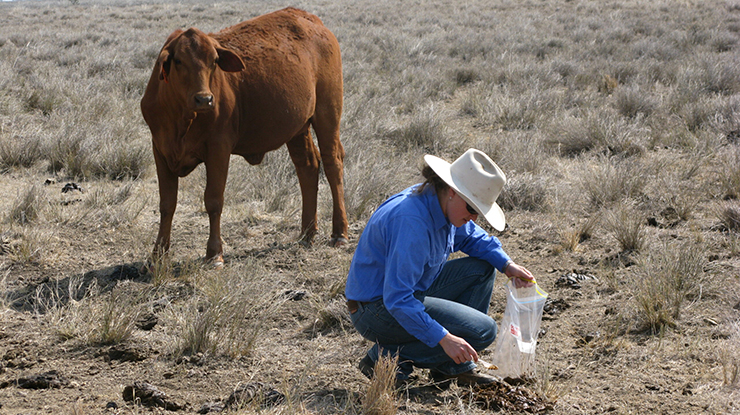 Testing can be done at any time however dung sampling done from the end of the growing season and during the dry season is ideal. Credit: FutureBeef
Testing can be done at any time however dung sampling done from the end of the growing season and during the dry season is ideal. Credit: FutureBeef
Key points:
- Dung samples can be analysed to estimate diet quality of cattle using faecal Near Infrared Reflectance Spectroscopy (F.NIRS).
- The key outcomes of the analysis include predicted estimates of dietary crude protein (CP), dry matter digestibility (DMD) and the non-grass proportion of diet.
- Results from F.NIRS can support decisions around grazing land management including timing of supplementation, growth estimates and weaning management.
Using Near Infrared Reflectance Spectroscopy (NIRS) to analyse dung towards the end of the pasture growing season provides a quick, cheap and reliable prediction of your herd’s diet quality.
MLA Beef Productivity Manager, Lindsey Perry, said dung sampling can be a useful decision-making tool in northern cattle production systems.
“F.NIRS analysis of dung samples for cattle grazing tropical northern pastures indicate the nutritional status of a herd. Results can be used to make more informed grazing management and nutrition decisions,” Lindsey said.
What to look for
The key outcomes of the analysis include predicted estimates of dietary crude protein (CP), dry matter digestibility (DMD) and the non-grass proportion of diet.
The DMD value is expressed as a percentage and indicates how much of what the animal grazes in the paddock is digested in the gastrointestinal tract.
Good quality, digestible pastures that support production should be above 55% in tropical grasses. As digestibility declines towards 50% or below energy will be limiting and animals will be maintaining or losing weight.
“The percentage of non-grass in the sample tells you that cattle are consuming legumes, forbs, or temperate grasses,” Lindsey said.
Another prediction included is ‘Ash’, which estimates how much soil has ended up in the dung sample. This could be from poor sampling technique or may indicate that feed quantity is too low and cattle are grazing close to the ground.
“It’s important to consider the values against what’s happening in the paddock.
“Is the quality good, but the quantity of feed limiting? Is the quality declining but cattle are in very good condition? Balance the results against other data and observations to make informed decisions.”
Local beef advisors or private consultants can provide useful support to interpret F. NIRS results appropriately.
Planning for your season
Testing can be done at any time, but during the pasture growing season, results will change quickly. Dung sampling done from the end of the growing season and during the dry season is ideal.
“Identifying the quality of your herd’s diet helps to determine when stock are likely to require supplements, when weaners should come off and when cattle are likely to lose condition.
“This way, producers can make strategic management decisions,” Lindsey said.
Testing is available at Gilmac Pty (Perth, WA) and Symbio Laboratories (Brisbane, Queensland).
“We encourage all producers to be proactive in their herd planning and F.NIRS analysis is one tool to support productive overall herd management.”







